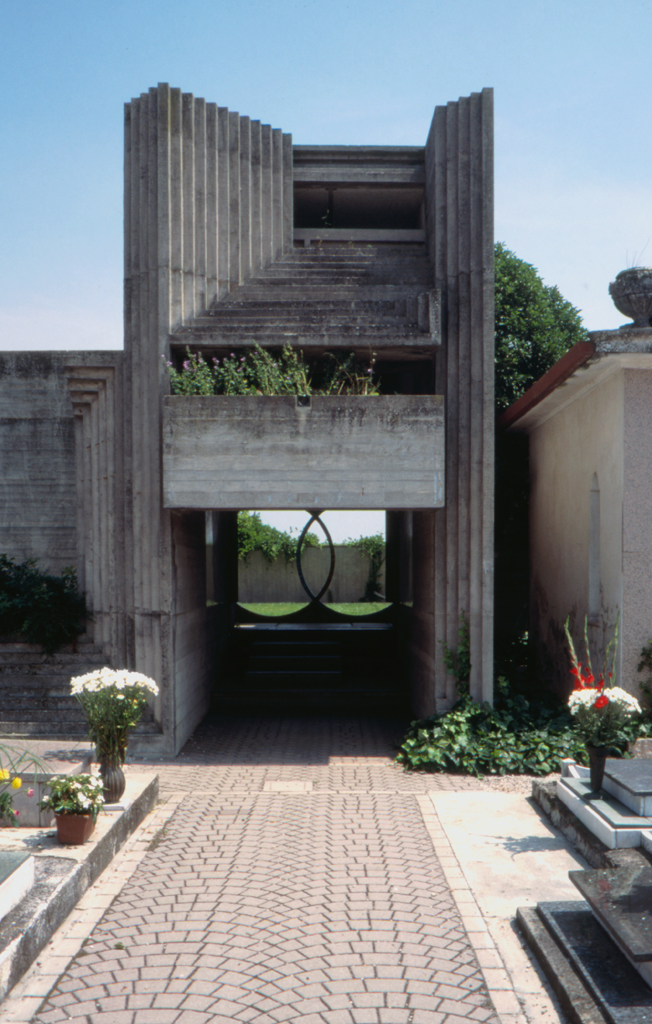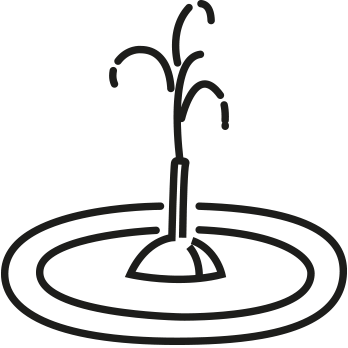
Giuseppe Brion, the founder of Brionvega – the electronics company famous for the Cubo television – died in 1968. His wife Onorina, wanting to memorialise her husband, extended the family plot at the local cemetery of San Vito d’Altivole, the village in the shadow of the Dolomites where Brion was born, and approached the Italian architect Carlo Scarpa to design his tomb.
Scarpa stood between the ancient and modern; in Venice – the old, crumbling city where he was born and lived – the architect introduced a modernism sympathetic to the canals and palazzi: the Olivetti showroom on St Mark’s Square; the Biennale ticket booths and the Venezuelan pavilion in the Giardini; the renovations of the Gallerie Dell’Accademia and the Fondazione Masieri. But it is his work with the Brion family, the only project he would “go to look at with pleasure”, that is his most studied and visited, and, ultimately, the place where he would be buried.
It started, simply, as a tomb, but between 1970 and 1978 the memorial would grow to include a chapel and meditation pavilion, all set around pools of water and surrounded by a garden, approached and enclosed by tall cypress trees. Rendered in concrete and ornamented with tile and glass and metal, the elaborate stepped surfaces evoke ancient Mesopotamian ziggurats, which raised temples closer to the heavens – a motif that echoes throughout the cemetery, creating bands of light and shadow, cutting through and framing rooms, corridors, and terraces. The steps, submerged in water, moulded into concrete, seem either to lead to something or nothing; it’s disorienting, but in a way that appeals to the subconscious, inviting you to move through the space. Scarpa described the complex as being designed with a sense of “poetic imagination”: “Not in order to create poetic architecture, but to make a certain kind of architecture that could emanate a sense of formal poetry.”
It’s a place rich in material symbolism, from the use of interlocking circles, which represent husband and wife; to the bodies of water, between and beneath the cemetery buildings, both life giving and morbid, the Nile and the Styx; and the way nature is left to grow over and around the structures. “The place for the dead is a garden,” Scarpa said. “I wanted to… approach death in a social and civic way; and further what meaning there was in death, in the ephemerality of life – other than these shoe boxes.”
Scarpa stood between the ancient and modern; in Venice – the old, crumbling city where he was born and lived – the architect introduced a modernism sympathetic to the canals and palazzi: the Olivetti showroom on St Mark’s Square; the Biennale ticket booths and the Venezuelan pavilion in the Giardini; the renovations of the Gallerie Dell’Accademia and the Fondazione Masieri. But it is his work with the Brion family, the only project he would “go to look at with pleasure”, that is his most studied and visited, and, ultimately, the place where he would be buried.
It started, simply, as a tomb, but between 1970 and 1978 the memorial would grow to include a chapel and meditation pavilion, all set around pools of water and surrounded by a garden, approached and enclosed by tall cypress trees. Rendered in concrete and ornamented with tile and glass and metal, the elaborate stepped surfaces evoke ancient Mesopotamian ziggurats, which raised temples closer to the heavens – a motif that echoes throughout the cemetery, creating bands of light and shadow, cutting through and framing rooms, corridors, and terraces. The steps, submerged in water, moulded into concrete, seem either to lead to something or nothing; it’s disorienting, but in a way that appeals to the subconscious, inviting you to move through the space. Scarpa described the complex as being designed with a sense of “poetic imagination”: “Not in order to create poetic architecture, but to make a certain kind of architecture that could emanate a sense of formal poetry.”
It’s a place rich in material symbolism, from the use of interlocking circles, which represent husband and wife; to the bodies of water, between and beneath the cemetery buildings, both life giving and morbid, the Nile and the Styx; and the way nature is left to grow over and around the structures. “The place for the dead is a garden,” Scarpa said. “I wanted to… approach death in a social and civic way; and further what meaning there was in death, in the ephemerality of life – other than these shoe boxes.”
Originally published in Port.

